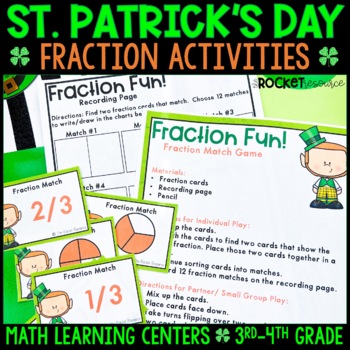St. Patrick's Day Fractions | St. Patty's Day Math
- PDF
- Internet Activities
Description
Want to add some St Patricks Day fraction fun into your math block? These fraction games will keep your students engaged and learning! Includes 5 different fraction activities-2 match games, board game, worksheet, and BOOM card deck.
How to Use: Use all the activities together in learning centers on St. Patrick's Day for your math instruction or spread activities out over the course of a week. Differentiate instruction based on student level of understanding of fractions.
FRACTION STANDARDS COVERED:
- 3.NF.1. Identifying fractions.
- 3.NF.2 Fractions on a number line.
- 3.NF.3 Identifying equivalent fractions.
- 4.NF.1 Identifying equivalent fractions.
- 4.NF.2 Comparing fractions.
- 4.NF.3 Adding fractions with like denominators.
⭐Do you want an entire day of standards-based, engaging St. Patrick's Day activities for all the subjects? Get the entire Leprechaun Day packet here! (All math pages from this resource are included in this packet.) ⭐
****************************************************************************************************************
WHAT'S INCLUDED:
- Fraction Match Games: 2 match game versions included. "Fraction Fun" practices identifying fractions. "Fiddlin' with Fractions" practices identifying equivalent fractions. Teacher and student direction pages included. Student recording page included.
- Comparing Fractions Game: Board game for 2-4 players practicing comparing fractions. Includes game board, game markers, game cards, student and teacher directions, answer key. Minimal prep needed-print out materials, cut out game cards.
- Fractions on a Number Line: Cut-&-Paste fractions on a number line worksheet
- Fractions BOOM deck: This boom deck practices adding fractions with like denominators. See directions below for what is needed.
WHAT YOU NEED FOR BOOM CARD DECK:
Boom cards must be used with the Internet. They can be played on recent browsers (Chrome, Safari, Firefox, etc.) or with the app (available for iPad, Android, iPhone, Kindle Fire). You can assign Boom cards for free using the "Fast Pins" option. For more options, you can sign up for a premium Boom Learning account.
**************************************************************************************************************
Don't forget that leaving feedback earns you points towards FREE TPT purchases. I love feedback.
Click here to follow me and be notified when new products are uploaded.
Visit me at The Rocket Resource Blog for helpful teacher tips and freebies!
***************************************************************************************************************
Copyright@The Rocket Resource.
All rights reserved by author.
Permission to copy for single classroom use only.





